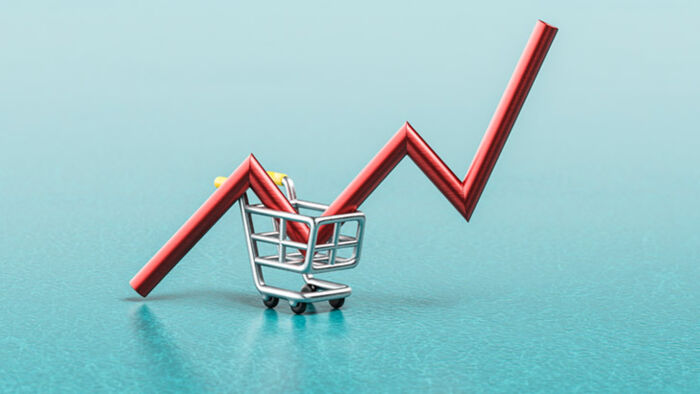Inflation rises to 4% fuelling fears of a rate hike
By Nicola Field
Inflation rises to 4% driving fears of rate hike, property profits hit 14-year high, NSW commuters face higher public transport fares. Here are five things you may have missed this week.
Inflation hits 4% fuelling fears of a hike in interest rates
It's the news none of us wanted to hear.
Inflation hit 4% in May, up from 3.6% in April, renewing fears of a 14th rate hike as the Reserve Bank of Australia (RBA) aims to push inflation down to 2-3%.
However, nothing is set in stone.
The RBA won't make another rate call until August, by which stage a fresh batch of CPI figures for June will be available.
Michelle Marquardt, ABS head of prices statistics, adds a hopeful note, saying "CPI inflation is often impacted by items with volatile price changes like automotive fuel, fruit and vegetables, and holiday travel." If these items are excluded Marquardt says underlying inflation was 4.0% in May, down from 4.1% in April.
Either way, RBA Governor Michelle Bullock has noted, "It's going to be a slow grind to bring inflation back." She says the central bank is "hoping" to have inflation down to 2-3% by the end of next year.
Monthly inflation data has only been published since 2022, and it's not as comprehensive as the more traditional quarterly numbers, updating prices for only two-thirds of the overall CPI basket.
Property profits hit 14-year high
Homeowners who resold a property in the March quarter pocketed bumper gains.
Of the 85,000 properties sold in the quarter, over 94% dished up a profit according to CoreLogic's latest Pain & Gain report. It is the highest rate of profit-making sales since July 2010.
Houses sold for a median profit of $320,000, compared to $172,000 for apartments.
Brisbane topped the charts for profit-making sales, with 99.4% of properties sold for a gain.
Darwin took out the wooden spoon, with around one in five (19.7%) homes sold for a loss.
The big money went to those who had held onto property for long periods.
Among owners who sold after just two years, the median profit on sale was $80,000 - a far cry from the $275,000 median gain on homes held for 10-12 years.
The biggest reward went to owners with a healthy dose of patience. Homes resold after 30 years notched up a median profit of $780,000.
The profit-making is unlikely to stop there.
Domain is predicting house prices to rise 3-6% over the next 12 months, with Perth (up 8-10%), Adelaide (7-9%) and Brisbane (6-8%) expected to top the leaderboard of gains.
Opal fares to jump 3.6% from next week
NSW residents will need to dig deeper for public transport fares from July 1, when Opal prices will rise by an average of 3.6%.
Adult fares for train and metro trips will increase by up to 49 cents, 27 cents for bus and light rail trips and 43 cents for a ferry trip.
The weekly fare cap will stay at $50 for adults and $25 for child/youth and concession card holders. Seniors and pensioners will be charged no more than $2.50 per day according to Transport NSW.
If you prefer the comfort of your own car, be sure to buckle up.
From July 1, overhead cameras in NSW will start detecting drivers and passengers who aren't wearing a seatbelt. Fines can start at $387 but as drivers are responsible for passenger safety, the person behind the wheel can cop a fine if passengers aren't securely belted in.
Australia's first super-backed build-to-rent-to-own homes come to market
The nation's largest super fund, AustralianSuper, has completed its first build-to-rent-to-own (BTRTO) housing development in Melbourne's northwest, in conjunction with property developer and operator Assemble.
The BTRTO model allows residents to lock in their rent and purchase price for up to five years, with the option to buy their home at any stage at an agreed value. This eliminates the potential for rising rents and property prices to derail residents' plans to buy a place of their own.
Optional money coaching support is available to residents to help them achieve home ownership.
The apartments at 15 Thompson Street, Kensington range from studios to 3-bedders, and are listed with rents starting from $427 per week or to buy from $450,000.
AustralianSuper chief executive Paul Schroder says, "Australia's housing supply crisis needs collaboration and new solutions, and projects like Thompson Street demonstrate the kind of fresh thinking needed to create more homes for Australians now and strong, long-term returns for (super fund) members in the future."
The most expensive colour of car to insure
Australians may be facing a cost of living squeeze but that hasn't stopped us flocking to buy new cars.
May saw an all-time monthly record of 111,099 vehicles sold, driving sales for the year to date to more than half a million.
If you're in the market for a new set of wheels, there's more to consider than the make or model.
Analysis by Compare the Market found the colour of a car can drive up insurance premiums.
Not all insurers base premiums on colour but among those that do, darker-coloured cars tend to attract higher insurance premiums than their lighter counterparts.
A black car, for example, can cost 8.72% more to insure than the same vehicle in white. The premiums can be 7.89% higher for silver and grey cars.
It follows a study by Monash University that found a "statistically significant relationship" between vehicle colour and crash risk.
Compared to white vehicles, a number of colours were associated with higher crash risk including black, blue, grey, green, red and silver.
Get stories like this in our newsletters.



